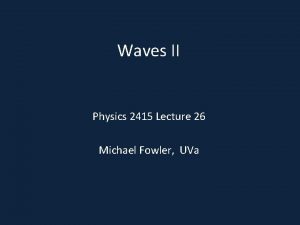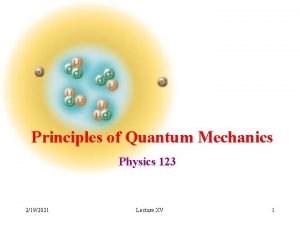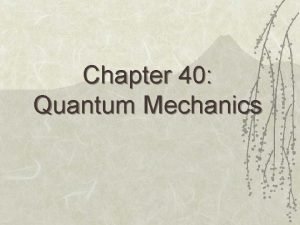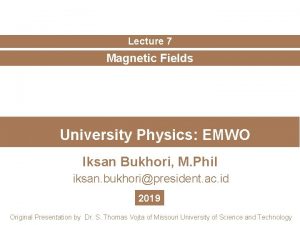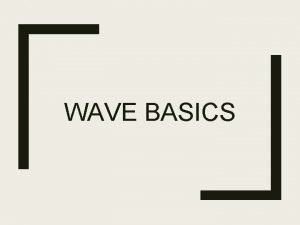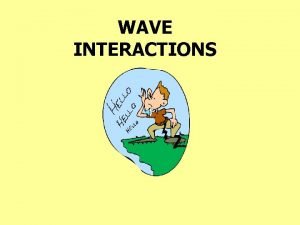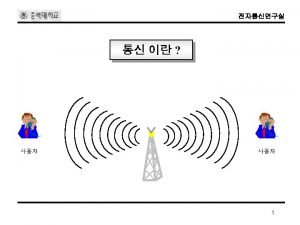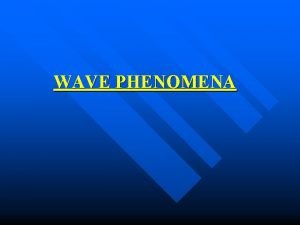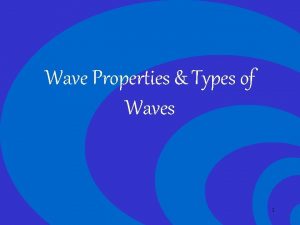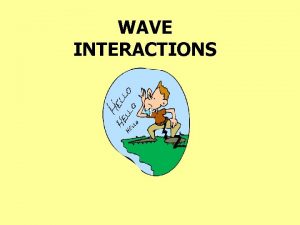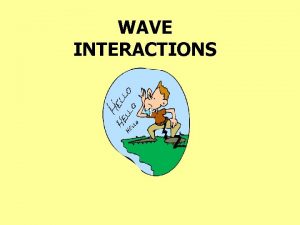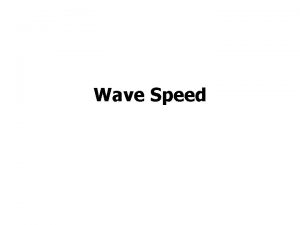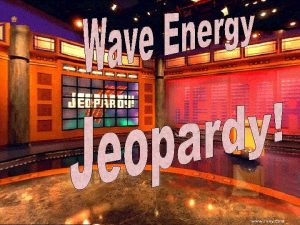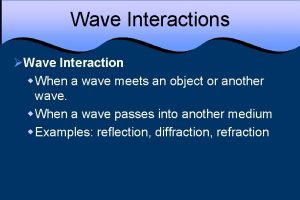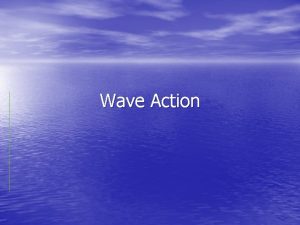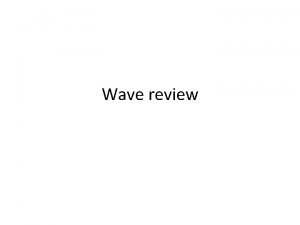Lecture 2 Wave Mechanics University Physics Mechanics Iksan
























- Slides: 24

Lecture 2 Wave Mechanics University Physics: Mechanics Iksan Bukhori, M. Phil iksan. bukhori@president. ac. id 2019

Textbook: “Fundamentals of Physics”, Halliday, Resnick, Walker, John Wiley & Sons, 8 th Extended, 2008. Syllabus: (tentative) Chapter 15: Simple Harmonic Motion Chapter 16: Transverse Waves Chapter 17: Longitudinal Waves Chapter 21: Coulomb’s Law Chapter 22: Finding the Electric Field – I Chapter 23: Finding the Electric Field – II Chapter 24: Finding the Electric Potential Chapter 26: Ohm’s Law Chapter 27: Circuit Theory Iksan Bukhori Physics II 1/2

Grade Policy Grade Point: 85 – 100 70 – 84 60 – 69 55 – 59 0 – 54 : A : B : C : D : E (GPA = 4) (GPA = 3) (GPA = 2) (GPA = 1) (GPA = 0) § The use of smartphone calculator in quizzes and exams is prohibited. Iksan Bukhori Physics II 1/3

Grade Policy Grades: Final Grade = 10% Homeworks + 20% Quizzes + 30% Midterm Exam + 40% Final Exam + Extra Points § Homeworks will be given in fairly regular basis. The average of homework grades contributes 10% of final grade. § Homeworks are to be written on A 4 papers, otherwise they will not be graded. § Homeworks must be submitted on time, on the schedule of the lecture. If you submit late, the penalty will be – 10·n points, where n is the total number of lateness made. § There will be 2 quizzes. The average of quiz grades contributes 20% of final grade. § Midterm and final exam schedule will be announced in time. Iksan Bukhori Physics II 1/4

Grade Policy § Extra points will be given if you solve a problem in front of the class. You will earn 1, 2, or 3 points. § Make up of quizzes and exams will be held within one week after the schedule of the respective quizzes and exams. § To maintain the integrity, the maximum score of a make up quiz or exam can be set to 90. Basic Physics 1 Homework 6 Rudi Bravo 009201700008 21 March 2021 No. 1. Answer: . . . . Heading of Homework Papers (Required) Iksan Bukhori Physics II 1/5

Lecture Activities § Lectures will be held in the form of Power. Point presentations. § You are expected to write a note along the lectures to record your own conclusions or materials which are not covered by the lecture slides. How to get good grades in this class? • Do the homeworks by yourself • Solve problems in front of the class • Take time to learn at home • Ask questions Iksan Bukhori Physics II 1/6

Lecture Material § Latest lecture slides will be uploaded to my blog iksanbukhori@wordpress. com § You are responsible to read and understand the lecture slides. I am responsible to answer your questions. § Quizzes, midterm exam, and final exam will be open-cheat sheets. Be sure to have your own copy of lecture slides. You are not allowed to borrow or lend anything during quizzes or exams. § But: A homework can be submitted late without penalty if a scanned or photographed version of the homework is sent to iksan. bukhori@president. ac. id at least one day before the schedule of the class. Iksan Bukhori Physics II 1/7

Extra Assignments § There will be no remedial for any quizzes nor exams. § As replacement, you may submit a neat summary of your notes or collection of problems and solutions related to all topics covered up to that point in handwritten with A 4 paper § This extra assignment will not be announced beforehand has to be submitted one day after your quiz/exams paper is returned § The extra grade depends on the materials covered, how neat it is and how good your understanding of the materials actually is (Copying my slides or the book(s) will not do) Iksan Bukhori Physics II 1/8

Electric Charge § Static cling, an electrical phenomenon that accompanies dry weather, causes the pieces of paper to stick to one another. This is an example that reveals the existence of electric charge. § In fact, every object contains a vast amount of electric charge. § Electric charge is an intrinsic characteristic of the fundamental particles making up those objects. § The vast amount of charge in an everyday object is usually hidden because the object contains equal amounts of the two kinds of charge: positive charge and negative charge. § With such a balance of charge, the object is said to be electrically neutral (contains no net charge). § If the two types of charge are not in balance, we say that an object is charged, it has a net charge. Iksan Bukhori Physics II 1/9

Electric Charge § Charged objects interact by exerting forces on one another. § Charges with the same electrical sign repel each other, while charge with opposite electrical signs attract each other. § This rule will be described quantitatively as Coulomb’s law of electrostatic force between charges. (The term electrostatic is used to emphasize that the charges are stationary relative to each other. ) Iksan Bukhori Physics II 1/10

Coulomb’s Law § If two charged particles are brought near each other, they each exert a force on the other. § If the particles have the same sign of charge, they repel each other. The force on each particle is directed away from the other particle. § If the particles have opposite signs of charge, they attract each other. The force on each particle is directed toward the other particle. Iksan Bukhori Physics II 1/11

Coulomb’s Law § This force of repulsion or attraction due to the charge properties of objects is called an electrostatic force. § The equation giving the force for charged particles is called Coulomb’s law, named after Charles-Augustin de Coulomb, who did the experiments in 1785. § If particle 1 has charge q 1 and particle 2 has charge q 2, the force on particle 2 is: § The term is a unit vector to the direction from position of q 1 to position of q 2. The term k is a constant. Iksan Bukhori Physics II 1/12

Coulomb’s Law § ε 0 is a constant denoted as permittivity in vacuum, a measure of how the vacuum medium is affected by an electric field. § As can be deducted from the constants, the SI unit of charge is the coulomb (C). y q 1 + r→ 12 → r 1 → r 2 + q 2 → F 2 x Iksan Bukhori Physics II 1/13

Some Examples on Vectors § Example: If , find § Example: If and . , find and . § Both vectors are of opposite direction, but have the same magnitude Iksan Bukhori Physics II 1/14

Coulomb’s Law § If we have n charged particles, they interact independently in pairs, and the force on any one of them, is given by the vector sum. § Let us say, we have n particles, then the force on particle 1 is given by: y + q 1 q 2 → F 21 + q 3 – → F 23 → F 2, net x Iksan Bukhori Physics II 1/15

Example 1: Coulomb’s Law The figure below shows two positively charged particles fixed in place on an x axis. The charges are q 1 = 1. 6 10– 19 C and q 2 = 3. 2 10– 19 C. The q 1 is located on the origin, while the separation is R = 0. 02 m. → What are the magnitude and direction of the electrostatic force F 12 on particle 1 from particle 2? Iksan Bukhori Physics II 1/16

Example 2: Coulomb’s Law Now, particle 3 lies on the x axis between particles 1 and 2. Particle 3 has charge q 3 = – 3. 2 10– 19 C and is at a distance 3/4 R from particle 1. → What is the net electrostatic force F 1, net on particle 1 due to particles 2 and 3? Iksan Bukhori Physics II 1/17

Example 3: Coulomb’s Law Particle 3 from previous example is now replaced by particle 4. Particle 4 has charge q 4 = – 3. 2 10– 19 C, is at a distance 3/4 R from particle 1, and lies on a line that makes an angle θ = 60° with the x axis. → What is the net electrostatic force F 1, net on particle 1 due to particles 2 and 4? Iksan Bukhori Physics II 1/18

Example 3: Coulomb’s Law Iksan Bukhori Physics II 1/19

Checkpoint The figure below shows three arrangements of one electron (e) and two protons (p). (a) Rank the arrangements according to the magnitude of the net electrostatic force on the electron due to the protons, largest first a, c, b (b) In situation c, is the angle between the net force on the electron and the line labeled d less than or more than 45 °? Less than 45° Iksan Bukhori Physics II 1/20

Example 4: Coulomb’s Law Two particles are fixed in place: a particle of charge q 1 = +8 q at the origin and a particle of charge q 2 = – 2 q at x = L. At what point can a particle of → F 32 charge q 3 = +4 q be placed so that it is in equilibrium (the net force on q 3 F→ 31 is zero)? : impossible to place q 3 on the left of q 1 or in the middle between q 1 and q 2 → F 32 : the only possibility is to place q 3 to the right -hand side of q 2 Iksan Bukhori → F 32 → F 31 Physics II 1/21

Example 4: Coulomb’s Law • q 3 between q 1 and q 2 • q 3 to the right of q 2 Iksan Bukhori Charge q 3 must be placed on the x axis, at distance L to the right of q 3, or, at point (2 L, 0) Physics II → F 32 L x → F 31 1/22

Charge Is Quantized § Experiment shows that electric charge is not continuous but is made up of multiples of a certain elementary charge (quantized). § Any positive or negative charge q that can be detected can be written as in which e, the elementary charge, has the approximate value § The elementary charge e is one of the important constants of nature. The electron and proton both have a charge of magnitude e. Iksan Bukhori Physics II 1/23

Exercise Problems 1. Three point charges are arranged along the xaxis. Charge q 1 = +3 μC is at the origin, and the charge q 2 = – 5 μC is at x = 0. 2 m. Charge q 3 = – 8 μC. Where is q 3 located if the net force on q 1 is 7 N in the negative x-direction? Answer: x = – 0. 144 m. 2. Two point charges are located on an xy-plane as follows. The first charge, q 1 = 2 μC is located at (2, 4). The second charge, q 2 = – 3 μC is located at →. (1, 6). Determine the force vector acting on q 2, i. e. F 21 → = 4. 824 i – 9. 649 j m. N Answer: F 21 ^ Physics II ^ Iksan Bukhori 1/24
 University physics with modern physics fifteenth edition
University physics with modern physics fifteenth edition 01:640:244 lecture notes - lecture 15: plat, idah, farad
01:640:244 lecture notes - lecture 15: plat, idah, farad Physics 111 lecture notes
Physics 111 lecture notes Physics 101 lecture notes pdf
Physics 101 lecture notes pdf Physics 101 lecture 1
Physics 101 lecture 1 Physics 101 lecture notes pdf
Physics 101 lecture notes pdf Waves physics pdf
Waves physics pdf Atmospheric physics lecture notes
Atmospheric physics lecture notes Electromagnetic waves are longitudinal waves true or false
Electromagnetic waves are longitudinal waves true or false What is a semiconductor used for
What is a semiconductor used for Difference between full wave and half wave rectifier
Difference between full wave and half wave rectifier Transverse and longitudnal waves
Transverse and longitudnal waves Half wave full wave rectifier
Half wave full wave rectifier Full wave bridge rectifier diagram
Full wave bridge rectifier diagram P and s wave arrival time chart
P and s wave arrival time chart Full wave rectified sine wave fourier series
Full wave rectified sine wave fourier series Nature of sound wave
Nature of sound wave Wave wave repeating
Wave wave repeating Symmetry in fourier series
Symmetry in fourier series Mechanical and electromagnetic waves venn diagram
Mechanical and electromagnetic waves venn diagram Venn diagram mechanical and electromagnetic waves
Venn diagram mechanical and electromagnetic waves Wavelength formula triangle
Wavelength formula triangle Standing wave equation
Standing wave equation Quantum physics wave function
Quantum physics wave function Quantum physics wave function
Quantum physics wave function






















